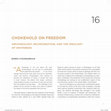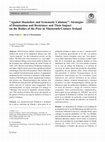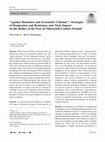Papers by Barra O'Donnabhain

Archaeology Outside the Box, 2023
George Floyd was killed by police during an arrest in Minneapolis on 25 May 2020, and his death i... more George Floyd was killed by police during an arrest in Minneapolis on 25 May 2020, and his death is yet another example of the vulnerability of Americans of color when it comes to dealings with the criminal justice system in the United States. This chapter seeks, in a small way, to address the challenges to archaeology as a discipline-contained in the statement of the Society for American Archaeology-by looking at one problematic aspect of the criminal justice system in the United States: incarceration. Due to its emergence as a democratic constitutional republic (at least for some) at the time when all people in Europe were ruled by despotic monarchies with intolerant state religions, the national self-image that emerged in the United States is one of a bastion of freedom and democracy. 1 The concept of liberty plays a central role in American nationalism. It promotes an exceptionalist perspective where the country Archeology Outside the box_Last 3.indd 217 1/16/23 10:44 PM
We dedicate this book to the volunteers and staff of today's Spike Island in acknowledgement of t... more We dedicate this book to the volunteers and staff of today's Spike Island in acknowledgement of their devotion to the island's past, present and future. vi vii Table of Contents A Note on the Book's Title ix A Note on Primary Sources ix A Note on the Name of the Prison xiv A Note on Images xiv Introduction: Spike Island, History and Legend 4 1. Crimes and Convictions 6 2. The First Convicts 16 3. The Geography of a Prison 25 4. In Mitchel's Time 37 5. The Prison Staff 55 6. Expansion and Escapes 69 7. The Infamous William Burke Kirwan 94 8. Change and Reorganisation 9. Accusations and Machinations 10. The Murder of Warder William Reddy
The 84th Annual Meeting of the Society for American Archaeology, 2019

This book and its 2014 companion volume (Archaeological Human Remains: Global Perspectives) exami... more This book and its 2014 companion volume (Archaeological Human Remains: Global Perspectives) examine current and future trends in studies of archaeological human remains. The papers address the influences that different geopolitical contexts have on the study of this category of archaeological material and how such remains are used to address broader anthropological issues. Throughout both volumes, the themes of race and colonialism appear in every paper. While case studies include countries that were colonisers, the majority of those profiled are post-colonial societies. Both imperial powers and imperial subjects were transformed by the colonial relationship, albeit in different ways. Science played an active role in this process both as a means of legitimising subordination and as a manifestation of power. Contrasting narratives have emerged from China and Russia that assert that studies of variation there were carried out in a spirit of egalitarianism. Both volumes chart the role of institutions and elites in the development of research into archaeological human bone, the influence of the state over those institutions and the manipulation of science by those in positions of power.
The 82nd Annual Meeting of the Society for American Archaeology, 2018

Historical Archaeology, Jan 14, 2020
Mid-Victorian British characterizations of Ireland and much of its population blamed race and "mo... more Mid-Victorian British characterizations of Ireland and much of its population blamed race and "moral character" for the widespread poverty on the island. The Irish poor were portrayed as a "race apart" whose inherent failings were at least partly to blame for the mortality they suffered during the Great Famine of 1845-1852. Recent excavations at Kilkenny workhouse and Spike Island convict prison have produced skeletal assemblages from this critical period. These collections have enabled bioarchaeological analysis of parameters mentioned by the Victorians as indicative of the distinctiveness of the Irish poor: stature, interpersonal violence, and tobacco use. Bioarchaeological data indicate that the differences between Irish and British populations in stature and risk of violence were exaggerated. Such characterizations, we argue, were part of a strategy of "Othering" that served to legitimize colonial domination. This exertion of power did not go uncontested, as the pattern of tobacco use may be indicative of forms of passive resistance. Extracto Las caracterizaciones británicas a mediados
The Encyclopedia of Archaeological Sciences, 2018

This book and its 2014 companion volume (Archaeological Human Remains: Global Perspectives) exami... more This book and its 2014 companion volume (Archaeological Human Remains: Global Perspectives) examine current and future trends in studies of archaeological human remains. The papers address the influences that different geopolitical contexts have on the study of this category of archaeological material and how such remains are used to address broader anthropological issues. Throughout both volumes, the themes of race and colonialism appear in every paper. While case studies include countries that were colonisers, the majority of those profiled are post-colonial societies. Both imperial powers and imperial subjects were transformed by the colonial relationship, albeit in different ways. Science played an active role in this process both as a means of legitimising subordination and as a manifestation of power. Contrasting narratives have emerged from China and Russia that assert that studies of variation there were carried out in a spirit of egalitarianism. Both volumes chart the role ...
Title Too beautiful for thieves and pickpockets: a history of the Victorian convict prison on Spi... more Title Too beautiful for thieves and pickpockets: a history of the Victorian convict prison on Spike Island Author(s) McCarthy, Cal; O'Donnabhain, Barra Publication date 2016-05 Original citation McCarthy, C. and O'Donnabhain, B. (2016) Too beautiful for thieves and pickpockets: a history of the Victorian convict prison on Spike Island. Cork: Cork County Library and Arts Service. isbn 9780992997014 Type of publication Book Rights © Cal McCarthy and Barra O’Donnabhain 2016 Item downloaded from http://hdl.handle.net/10468/2539

Historical Archaeology, 2020
Mid-Victorian British characterizations of Ireland and much of its population blamed race and “mo... more Mid-Victorian British characterizations of Ireland and much of its population blamed race and “moral character” for the widespread poverty on the island. The Irish poor were portrayed as a “race apart” whose inherent failings were at least partly to blame for the mortality they suffered during the Great Famine of 1845–1852. Recent excavations at Kilkenny workhouse and Spike Island convict prison have produced skeletal assemblages from this critical period. These collections have enabled bioarchaeological analysis of parameters mentioned by the Victorians as indicative of the distinctiveness of the Irish poor: stature, interpersonal violence, and tobacco use. Bioarchaeological data indicate that the differences between Irish and British populations in stature and risk of violence were exaggerated. Such characterizations, we argue, were part of a strategy of “Othering” that served to legitimize colonial domination. This exertion of power did not go uncontested, as the pattern of tobac...
Journal of Archaeological Science









Uploads
Papers by Barra O'Donnabhain